Trump Favorability Holds Steady Going Into Final Stretch of 2020 Campaign
Trump Favorability
Four in ten (40%) Americans currently hold favorable views of Donald Trump, compared to nearly six in ten (57%) who view him unfavorably. Trump’s favorability has remained largely stable since August (38% favorable, 59% unfavorable) and the prior few months, but it is substantially down from his high point in March (49% favorable, 46% unfavorable). The current numbers are about the same as his 2019 average (41% favorable, 55% unfavorable).
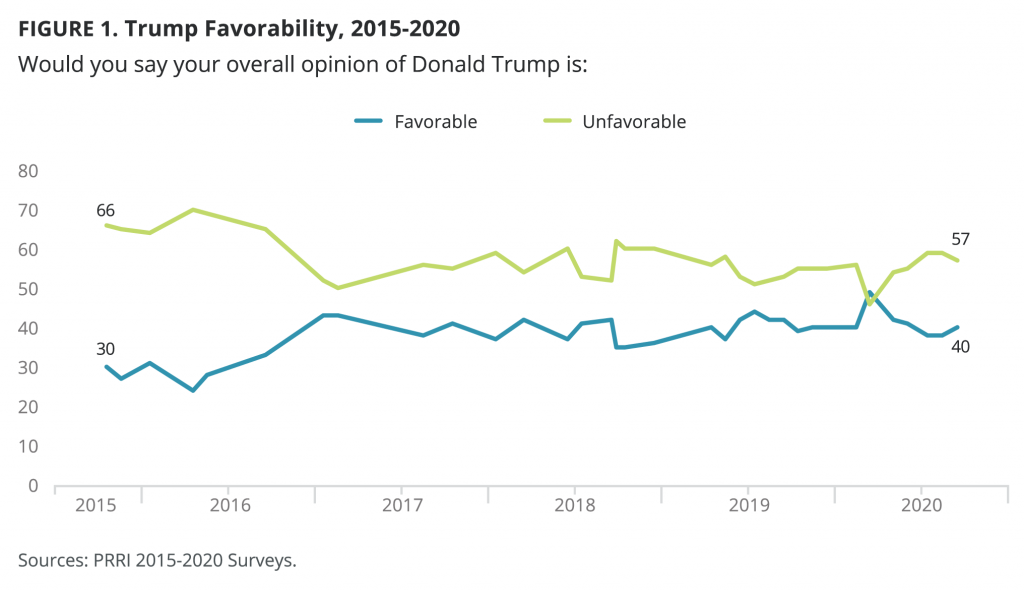
Party Affiliation
Nearly nine in ten (89%) Republicans hold favorable views of Trump, up from 82% in August, 84% in July, 83% in May, and similar to 90% in April and 89% in March. Trump’s favorability among Republicans is also higher than his 2019 average (79%). Among independents, 35% hold a favorable view of Trump, unchanged from most earlier measures, but down from 43% in April and 45% in March. Trump’s favorability among Democrats remains about the same today (9%) as it was in August (11%) and in July (7%), but it is lower than it was in May (14%) and across 2019 (15%).
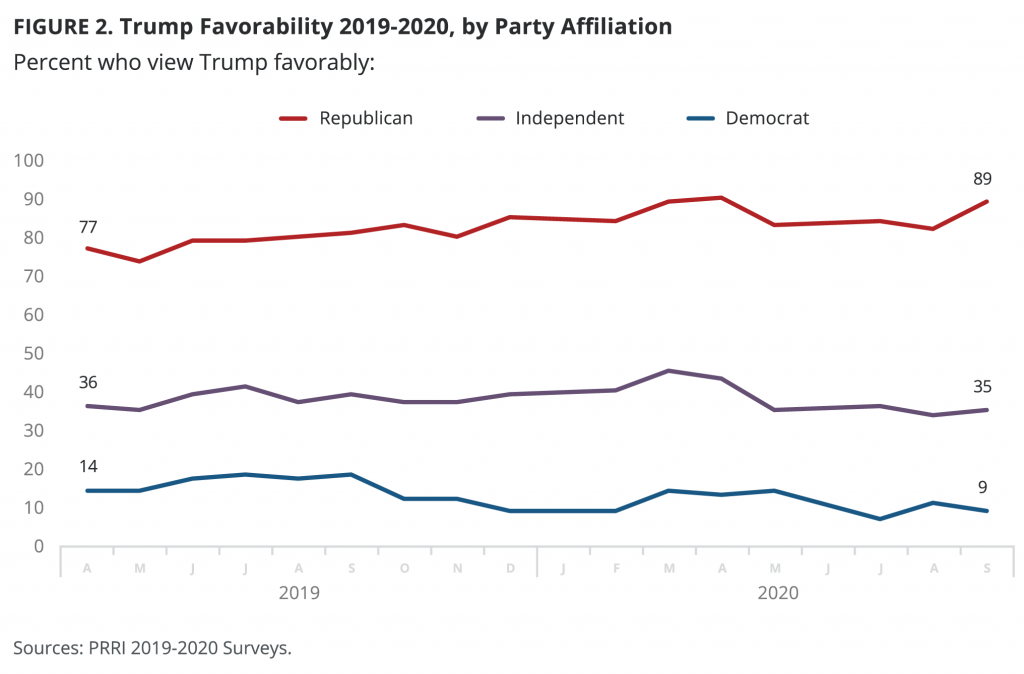
Religious Affiliation
More than seven in ten (71%) white evangelical Protestants, 54% of white Catholics, 49% of white mainline Protestants, 35% of nonwhite Protestants, and 26% of religiously unaffiliated Americans hold favorable views of Trump. [1]Compared to August, Trump’s favorability rose significantly among white evangelical Protestants (from 56% to 71%) and among white Catholics (from 38% to 54%), slightly higher than their 2019 average levels (64% and 49%, respectively). Among all white Christians, nearly six in ten (58%) hold favorable views of Trump, significantly higher than 47% in August and 54% throughout 2019.
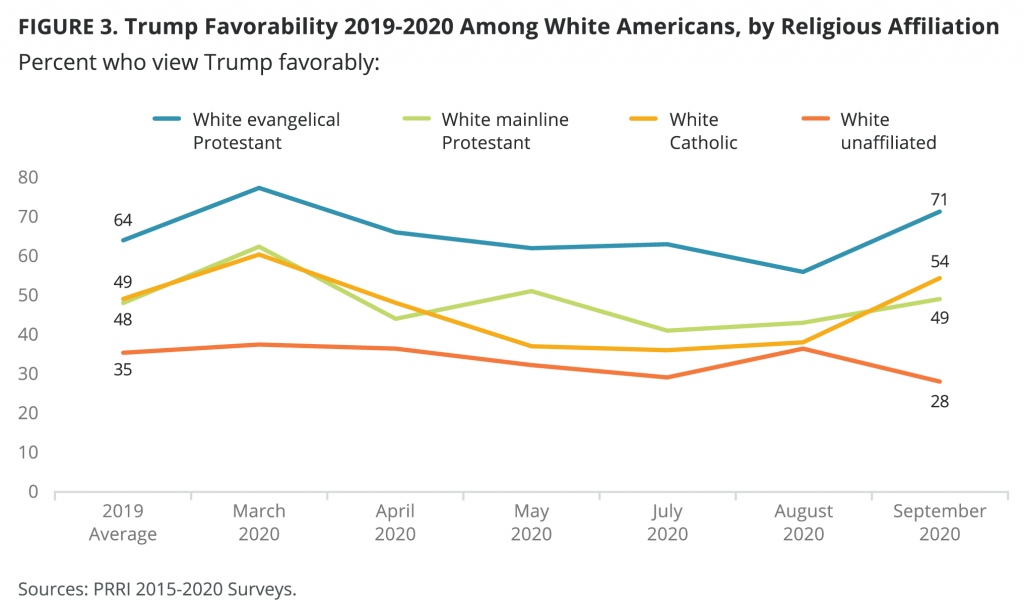
Race and Ethnicity, Gender, and Education
Nearly half (47%) of white Americans hold favorable views of Trump, compared to nearly one-third (32%) of Hispanic Americans and 14% of Black Americans. White, Hispanic, and Black Americans have not significantly changed their views compared to August (44%, 34% and 19%, respectively) or their 2019 averages (49%, 28% and 18%, respectively).
Men remain more likely than women to hold favorable views of Trump (47% vs. 35%), as in August (42% vs. 35%). This gap also appears between white men and white women. A majority of white men (53%) report favorable views of Trump, similar to 50% in August and 55% in 2019. By contrast, 41% of white women hold favorable views of Trump, similar to 37% in August and 42% in 2019.
Among white Americans without a four-year college degree, views of Trump have not substantially changed since August or from 2019 levels (49% favorable vs. 48% in August and 52% in 2019). By contrast, among white Americans with a four-year college degree, favorable views of the president increased by 8 percentage points from 35% in August to 43% today, but this shift is not statistically significant. Trump’s favorability ratings among white Americans with a four-year college degree remain the same as their 2019 average (43% today vs. 42% throughout 2019).
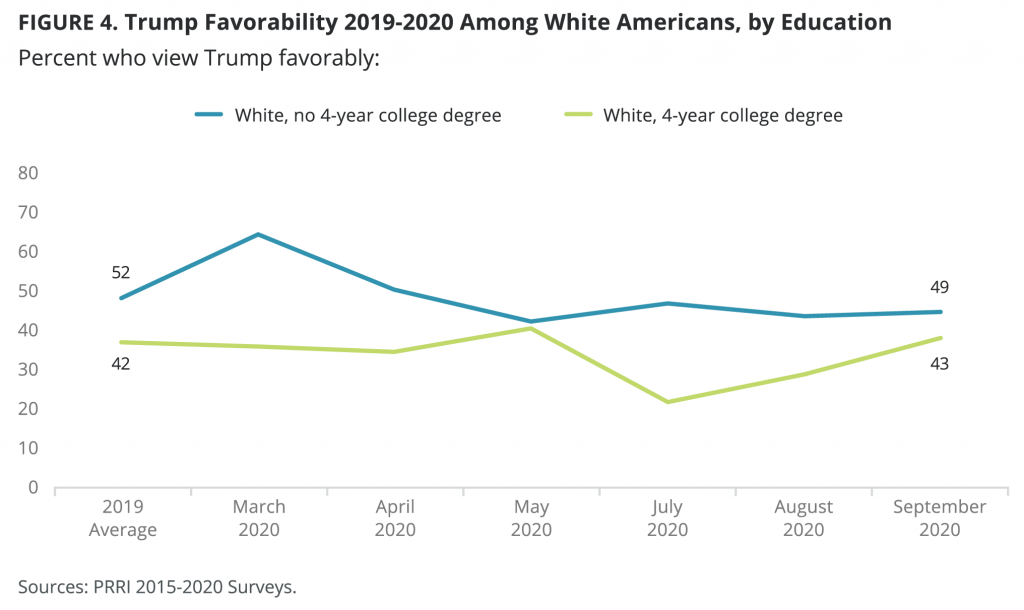
Age
Trump continues to have lower favorability ratings among younger Americans than older Americans. Among those ages 18-29, only 29% view the president favorably, a decrease from 34% in August, but this change is not statistically significant. Among Americans ages 30-49, Trump’s favorability is 46%, up significantly from 31% in August. By contrast, Trump’s favorability ratings remain unchanged among Americans ages 50-64 (45% today vs. 47% in August) and among seniors ages 65 and over (40% today vs. 43% in August).
2016 Battleground States
More than four in ten (41%) Americans who live in battleground states report favorable views of Trump, similar to 37% in August and 43% throughout 2019. [2]Nearly half (47%) of Americans who live in Republican or Republican leaning states hold favorable views of the president today similar to 44% in August and 46% throughout 2019. Among Americans who live in Democratic or Democratic leaning states, 35% hold favorable views of Trump today, similar to 33% in August, and 35% throughout 2019.
Biden Favorability
Favorable views of Joe Biden declined slightly in the last month, although the former vice president maintains stronger numbers than Trump. Less than half (46%) of Americans hold favorable views of Biden, down from a slim majority (51%) in August, but not significantly different from his July (48%) or September 2019 (48%) numbers.
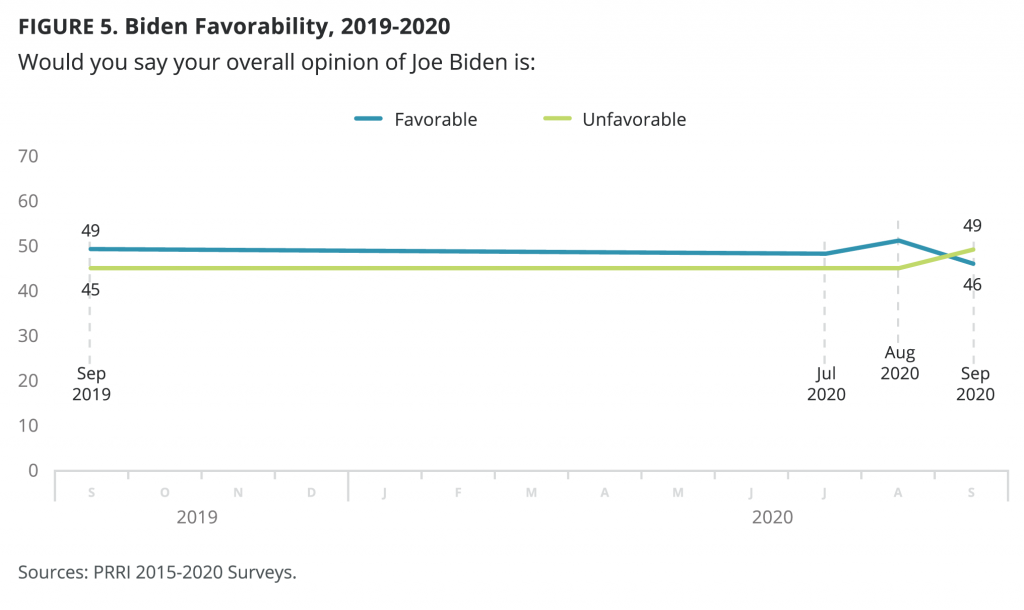
Party Affiliation
As with Trump, Americans have largely polarized along party lines in their views of Biden. Nearly nine in ten (89%) of Democrats express favorable views of Biden, slightly higher than the 83% of Democrats who said the same in August. Conversely, Republicans are slightly less likely to rate Biden favorably now (11%) than they were in August (18%). Independents (40%) have not shifted significantly since August (44%).
Favorable ratings among Democrats have steadily improved, but Biden has seen the most growth among moderate and conservative Democrats. Ratings among the moderate and conservative members of the party hovered around three in four, before climbing to 86% this month. Biden’s favorability among liberal Democrats has not increased significantly since August, but his numbers have increased steadily from 77% in September 2019 to 93% currently.
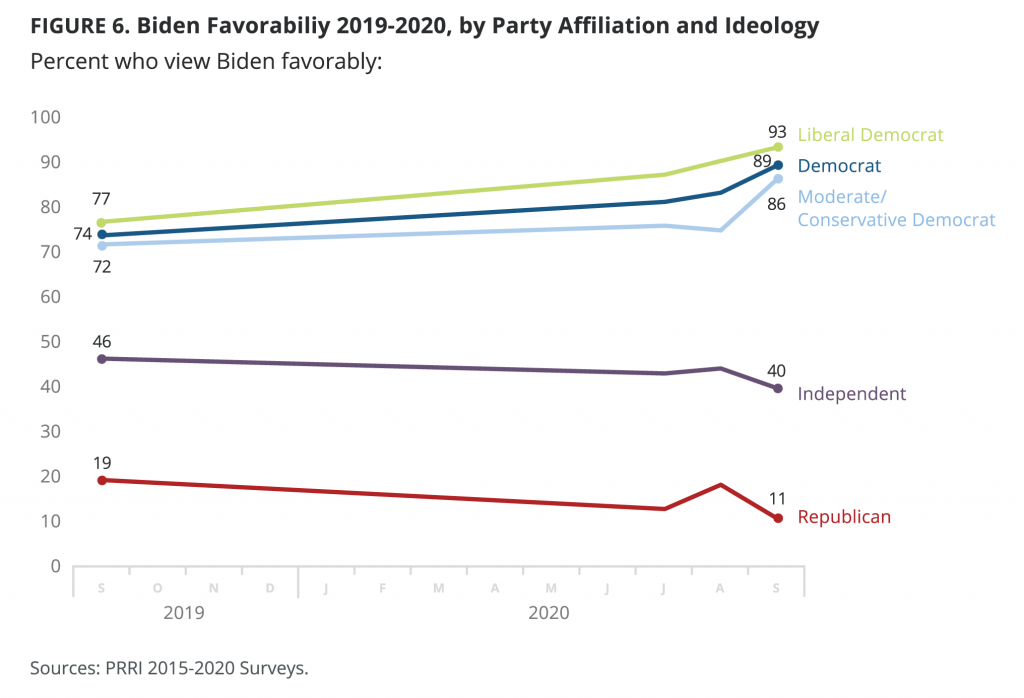
Religious Affiliation
Fewer than four in ten (37%) white Christians hold favorable views of Biden, similar to the 39% of white Christians who said the same in July. White mainline Protestants are twice as likely as white evangelical Protestants to hold favorable views of Biden (44% vs. 22%, respectively). Among white Catholics, 43% currently hold a favorable view of Biden, down significantly from 66% in August but in line with their views in September 2019 (44%). Majorities of nonwhite Protestants (59%) view Biden favorably. Biden’s favorability among religiously unaffiliated Americans has dipped from 54% in August to 47% currently, but this change is not statistically significant.
Race, Gender, and Education
Biden’s favorability has not shifted much among demographic subgroups. Four in ten (42%) white Americans express favorable views of Biden, compared to 71% of Black Americans and 52% of Hispanic Americans.[3]
Biden’s favorability among white men (36%) and white women (49%) remains similar to levels in August (42% and 53%, respectively) and July (36% and 52%, respectively). White Americans without a four-year college degree also express similar ratings of Biden (38%) as they did in August (42%) and July (35%). White Americans with at least a four-year college degree have trended downwards from 60% in July to 56% in August, to their current 49%, similar to the 52% who rated Biden favorably in September 2019.
Battleground States
Just under half (47%) of Americans in battleground states view Biden favorably, compared to a slim majority (52%) of residents of Democratic states, and four in ten (39%) residents of Republican states. Biden’s favorability in the battleground states remains relatively steady compared to July (49%) and August (52%).
Trump and Biden Among White Subgroups
Trump’s reelection chances largely hinge on maintaining support among groups of white Americans that helped him win in 2016. As the final stretch of the campaign plays out, Trump is viewed more favorably than Biden by white men (53% vs. 36%), white Americans without a four-year college degree (49% vs. 38%), and all subsets of white Christians. Notably, Trump’s favorability is higher than Biden’s among white Catholics (54% vs. 43%), a reversal from August when Trump was viewed less favorably than Biden by the group (38% vs. 66%).
Conversely, Trump is viewed less favorably than Biden among white women (41% vs. 49%), white Americans with a four-year college degree (43% vs. 49%), and white religiously unaffiliated Americans (28% vs. 50%).
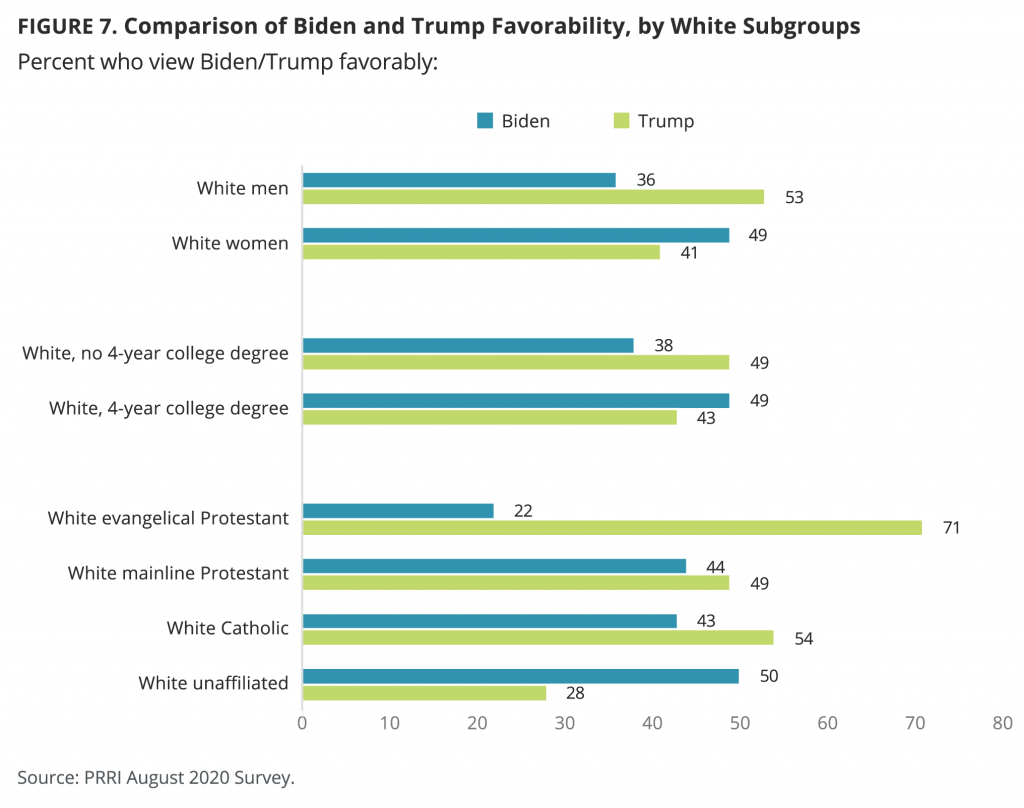
Methodology and Footnotes
Methodology: The survey was designed and conducted by PRRI. Results of the survey are based on bilingual (Spanish and English) RDD telephone interviews conducted between September 8 and September 16, 2020, by professional interviewers under the direction of SSRS. Interviews were conducted among a random sample of 1,003 adults 18 years of age or older living in the United States (704 respondents were interviewed on a cell phone). The margin of error for the survey is +/- 3.5 percentage points at the 95% level of confidence, which includes the design effect for the survey of 1.3.
[1] Sample size for Black Protestants, Hispanic Protestants, Hispanic Catholics, and non-Christian religions are too small to report individually. Protestant Christians who identify as Black, Hispanic, Asian or Pacific Islander, Native American, multiracial, or any other race are included in nonwhite Protestants.
[2] Battleground states are Arizona, Florida, Michigan, North Carolina, Pennsylvania, and Wisconsin. These states are listed in the “Toss-up” category by Cook Political Report, as of March 9th. These were the six closest races in 2016. The Cook battlegrounds were updated to only include Arizona, Georgia, Florida, and North Carolina in August, with Michigan, Pennsylvania, and Wisconsin moving to the “lean Democrat” column. Making these changes does not change the numbers above in statistically significant ways, therefore we have kept the original 6 battlegrounds as the closest 2016 states.
[3] Sample size of Black Americans is n=87. Use caution when interpreting results.




